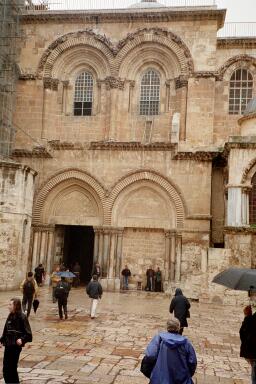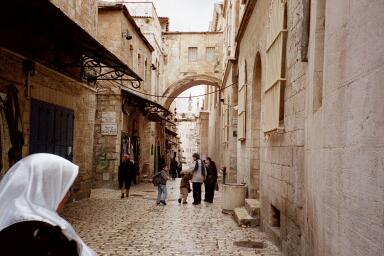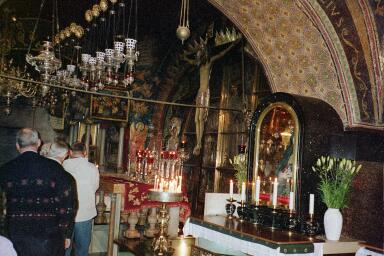
 It was a sabbath day in February 2001 and we followed the Via Dolorosa – the "sorrowful way". Tradition says that Jesus walked this way from the judgment seat to the cross. The Lonely Planet guidebook disagrees. For a number of good reasons, the route must have been different. Throughout history there are other routes that have made good claim.
It was a sabbath day in February 2001 and we followed the Via Dolorosa – the "sorrowful way". Tradition says that Jesus walked this way from the judgment seat to the cross. The Lonely Planet guidebook disagrees. For a number of good reasons, the route must have been different. Throughout history there are other routes that have made good claim.Yet here we were. February – no large crowd of pilgrims as would be the case during holy week. Sabbath – Jewish stalls closed, but some trade going on in the Arab quarter.
Our small band of eight were aware of, but didn’t go into, the various little chapels that have been built to mark the "stations of the cross." We weren’t in pursuit of the "exact spot," nor did we expect some special blessing from a lingering presence. The Jesus who walked all the way to the cross is alive. We have already known his presence and blessing in Australia.

Yet this is the country, the city, where it happened long ago. The mockery of a trial, the flogging, the presentation of Jesus with crown of thorns and scarlet robe (the Ecce Homo arch – "Here is the man!" Jn 19.5 – was built in Hadrian’s time, 100 years later), carrying his own cross, the help of Simon of Cyrene, the cruel Roman crucifixion... It happened here.
The Church of the Holy Sepulchre is said to be built on the spot where the crucifixion took place. Helena, the mother of Emperor Constantine in the fourth century, came on a pilgrimage and attempted to identify various sacred sites. The church with all its lanterns, people queued up to put their hand through a hole and feel the actual socket in the rock where the cross stood, a few prostrating themselves to kiss a marble slab on which the body may have been laid, another queue to go into the ornately preserved tomb... A Coptic chapel is built behind the tomb to allow people to touch the back of the rock. It stands as one of a number of reminders that there have been strong disagreements as various churches have wanted their "bit of the action" in this place.
 The prophet Isaiah said of the suffering Servant of the Lord, "He was despised and rejected by men, a man of sorrows and familiar with suffering" (Isaiah 53.3a).
The prophet Isaiah said of the suffering Servant of the Lord, "He was despised and rejected by men, a man of sorrows and familiar with suffering" (Isaiah 53.3a).
Jesus, on that sorrowful way, said, "Daughters of Jerusalem, do not weep for me, weep for yourselves and for your children" (Luke 23.28). His greatest sorrow wasn’t his own physical pain, but grief at the unbelief that was rejecting him, profound sadness at the consequences that would soon come upon Jerusalem and its inhabitants (19.42-44).
To quote Isaiah again, "Surely he took up our infirmities and carried our sorrows, yet we considered him stricken by God, smitten by him, and afflicted. But he was pierced for our transgressions, he was crushed for our iniquities; the punishment that brought us peace was upon him, and by his wounds we are healed. We all, like sheep, have gone astray, each of us has turned to his own way; and the Lord has laid on him the iniquity of us all" (Isaiah 53.4-6).
The "man of sorrows" was carrying our sorrows. He grieves at our unbelief. He offers to gather us into his grace.
| PRAYER: Lord Jesus, you came for us because you love us and grieve over our brokenness and unbelief. You understand suffering and grief. You took up our infirmities and carried our sorrows. Help us to trust in you, to rest in you, and in you to find hope and rest and peace. Amen. |
So great
his love!
So great
his gift!
He lives
to give
himself
to live
within me,
to live
and love
through me
that others
may know
his love
and life.
Back to Sermons